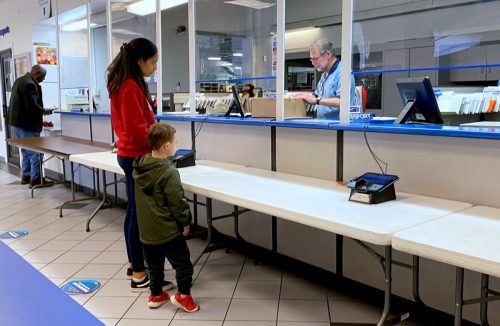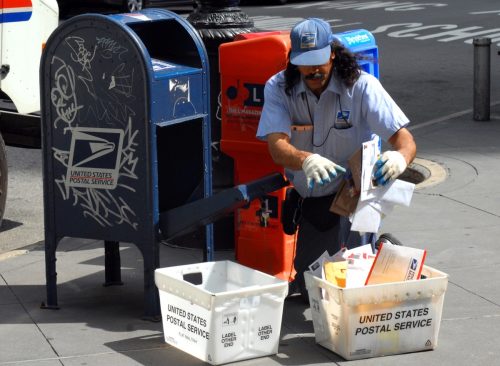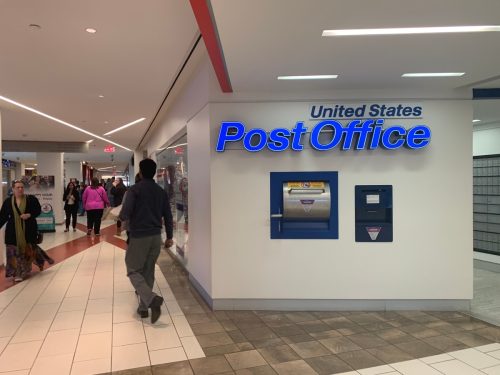USPS Is Planning New Changes to Your Mail, Starting Jan. 1

Over the past few years, the U.S. Postal Service (USPS) has been busy working to pull itself out of financial ruin. In 2021, the agency introduced its Delivering for America (DFA) initiative, which is a 10-year plan dedicated to getting the Postal Service back on track. As part of this transformation, customers have already been hit with multiple changes in the last two years—most notably the constant increase in mail prices. But now, the Postal Service is planning new adjustments to offset a decline in mail volume that could bring costs back down for certain customers. Read on to find out more about the USPS changes expected for next year.
RELATED: USPS Is Making These Changes to Your Mail, Starting Now.
The Postal Service just reported a decline in mail volume.

In an Aug. 8 press release, the USPS announced its results for the third quarter of the 2023 fiscal year (which ended June 30), and one of the biggest areas of concern was the Postal Service’s drop in mail volume.
According to the report, First-Class Mail volume declined by 678 million pieces, or 5.9 percent, compared to the same time period last year. Meanwhile, Marketing Mail volume fell by a staggering 2.6 billion pieces, or 16 percent.
“The Marketing Mail decreases were driven by the continued decline in advertising spending due to economic pressures experienced throughout most of the fiscal year, a higher inflationary environment affecting print media production costs, and lower political and election mail revenue and volume, compared to the same quarter last year, due to the timing of elections,” the agency stated in its release.
RELATED: USPS Just Issued a New Warning About Mailing Cash.
But the agency has been experiencing this drop for years now.

This isn’t a new problem for the USPS, however. The Postal Service was designed to be financially self-sufficient, but its business model broke about 15 years ago, Discourse Magazine reported.
After peaking at 213 billion pieces in 2006, the agency’s mail volume started plummeting, and it hasn’t stopped since. First-Class Mail has been hit the worst—dropping 53 percent from 103 billion in 2001 to just 48.9 billion in 2022, according to the news outlet.
In a May Congressional hearing, Postmaster General Louis DeJoy said the sharp decline in mail volume over the last decade and a half has “severely impacted” the agency’s finances, efficiency, and effectiveness. The fall in First-Class Mail volume has been the “most concerning,” because it is responsible for providing the greatest contribution toward covering the costs of the Postal Service’s network, according to DeJoy.
“At the same time, our cost to deliver mail continuously increased as our mail volume and revenue declined. This was driven by increased demand on our network, including the number of delivery points we serve, which had grown, and continues to grow, on average by more than one million delivery points each year,” he said. “Simply put, we were delivering less mail to more delivery points each year, which meant less revenue to cover increasing costs each year.”
RELATED: See a Sticker on Your Mailbox? Don’t Touch It, USPS Says.
The USPS is planning new changes as a result.

During the hearing, DeJoy told officials that these trends are expected to continue throughout the next decade—with a 36 percent total decline in mail volume projected by the 2030 fiscal year. In an attempt to offset this, the USPS is “launching a new initiative to address declines in mail volume,” the Federal News Network reported.
In an Aug. 11 press release, the Postal Service announced that it had filed notice with the Postal Regulatory Commission (PRC) of proposed plans to make certain Mail Classification Schedule (MCS) changes. These adjustments will allow the USPS to establish two new mail growth incentives: a First-Class Mail Growth Incentive and a Marketing Mail Growth Incentive.
“These two incentives will drive mail owners to increase the volume of First-Class and Marketing mail entering the network while providing them lower overall postage costs on incremental growth—allowing mail owners to maximize total return on investment, by providing additional cost-savings and strengthening the value of mail,” the agency said in its release.
RELATED: For more up-to-date information, sign up for our daily newsletter.
The mail growth incentives are set to start next year.

These changes are aimed at large mailers to help increase the amount of mail the USPS delivers after years of decline, Federal News Network explained. If approved by the PRC, the incentives will run from Jan. 1, 2024 to Dec. 31, 2024.
During this time, mail owners will have the opportunity to receive postage credits for helping grow First-Class Mail and Marketing Mail volumes beyond baselines, according to a separate Industry Alert from the Postal Service.
“Among the requirements to be eligible to claim the postage credits in each of these incentives, a mail owner must register for the incentive… mail at least one million qualifying pieces in calendar year (CY) 2024, and (C) mail more qualifying pieces in CY 2024 than they mailed in fiscal year (FY) 2023,” the USPS said it its alert. “Mail owners can participate in either or both Mail Growth Incentives, but the incentives cannot be combined for the purposes of reaching the million-piece minimums or for any other purpose. ”
As long as the incentives are approved by the PRC, the agency is planning to start registration for customers interested in taking part in November.
“Postage credits will be issued to qualified mail owners after six months, nine months, and twelve months from the start of CY 2024 and will be able to be used on future mailings until December 31, 2025,” the USPS stated.
- Source: https://about.usps.com/newsroom/national-releases/2023/0808-usps-reports-third-quarter-fiscal-year-2023-results.htm
- Source: https://about.usps.com/newsroom/testimony-speeches/pdf/051723.pdf
- Source: https://about.usps.com/newsroom/national-releases/2023/0811-usps-files-with-prc-to-establish-mail-growth-incentives.htm
- Source: https://postalpro.usps.com/node/12375